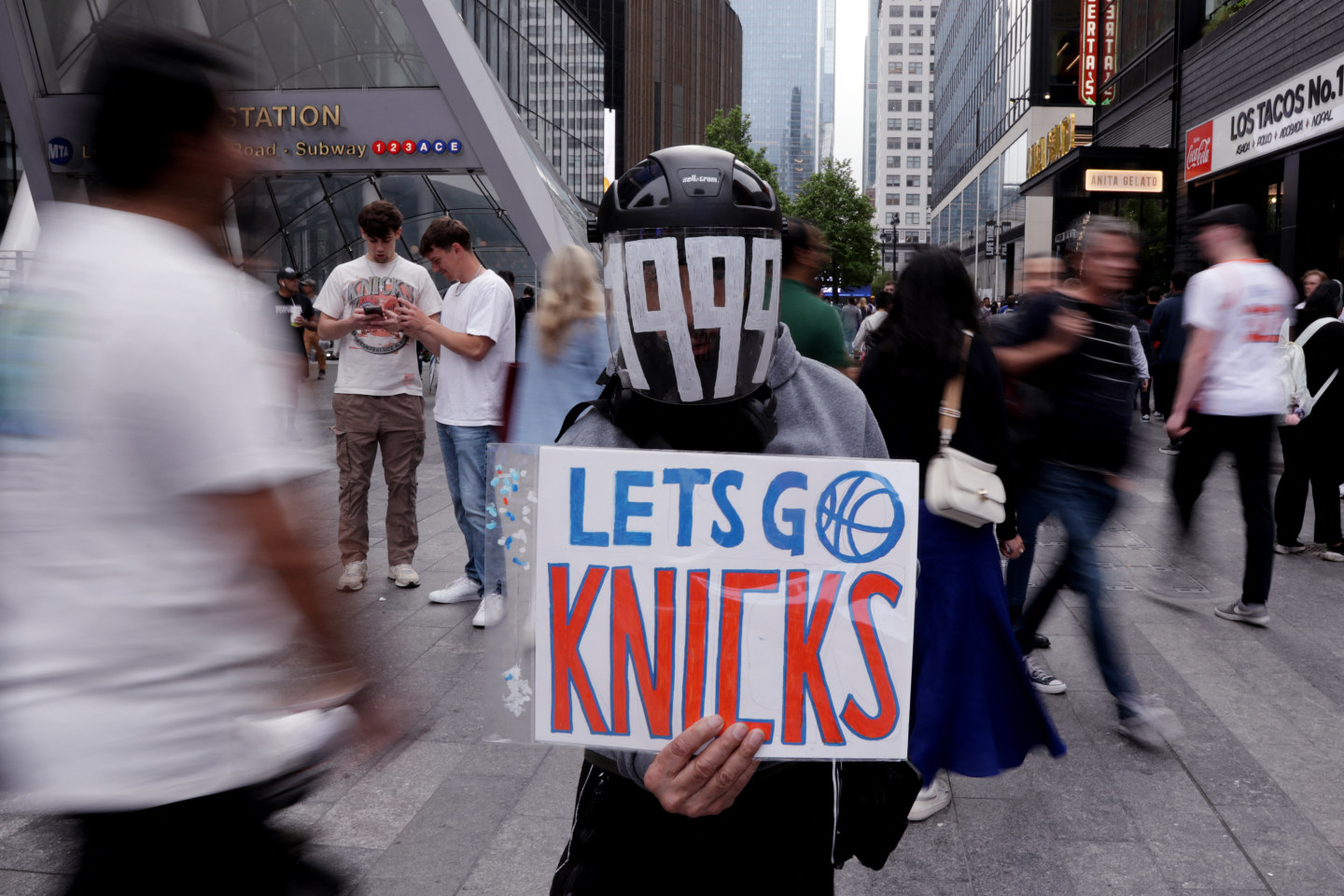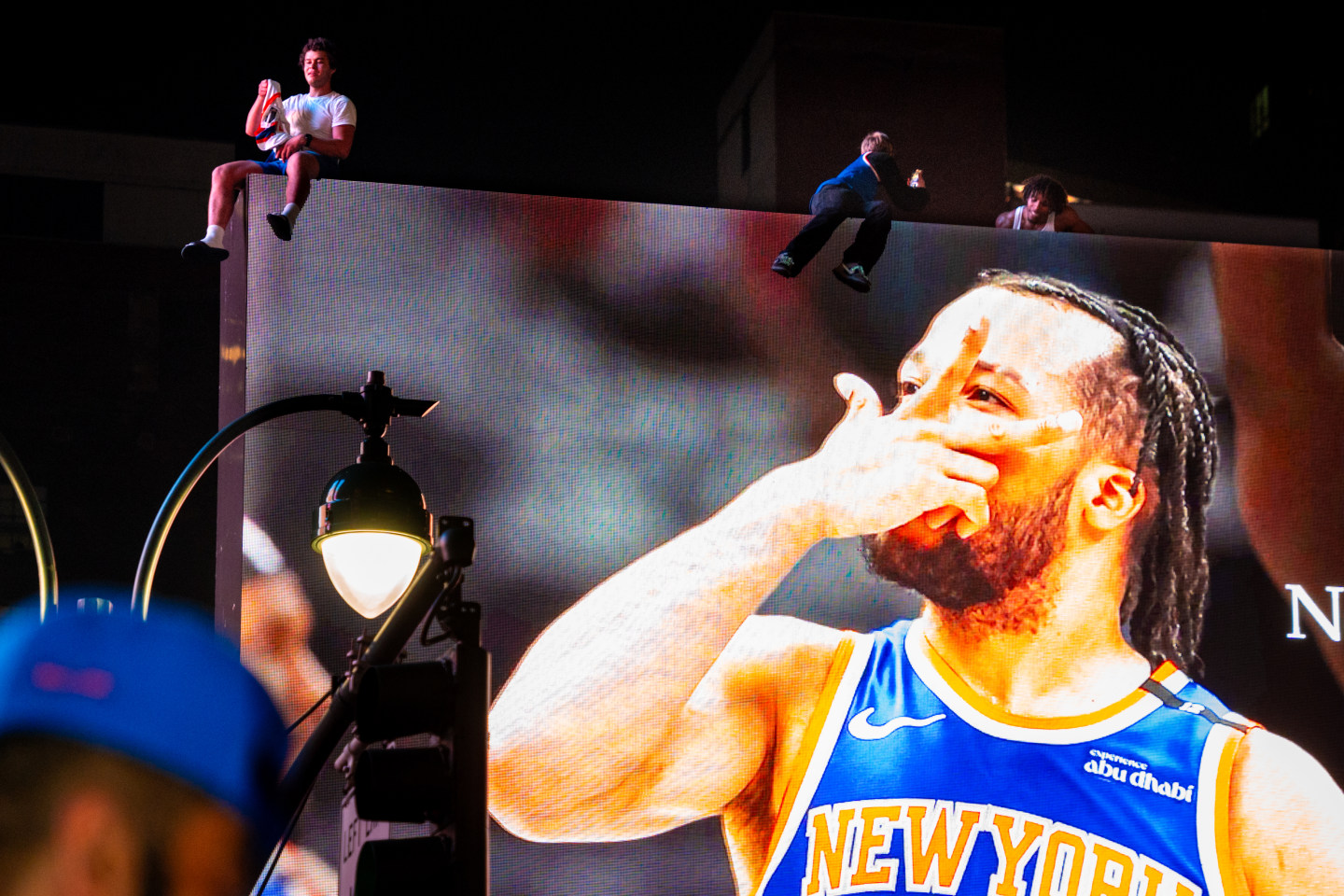New York basketball needs more than just the Knicks
Table of Contents
A generational playoff run has ignited a fast-changing city — one that may not be capable of nurturing basketball talent like it once was.

Photo by LEONARDO MUNOZ/AFP via Getty Images
Sometime in March of 2013, during a halftime broadcast of a March Madness game I can’t remember, I watched Kenny “The Jet” Smith make an impassioned tribute to his recently deceased high school basketball coach Jack Curran. He was a Queens legend, having coached Archbishop Molloy High School for fifty-five years, taking over for New York basketball icon Lou Carnesecca, who left to become an assistant basketball coach at St. John’s in 1958. Over his lifetime, Curran led Archbishop Molloy’s baseball and basketball teams to twenty-two New York City championships, establishing the kind of storied legacy that serves as a high school parallel to some of the great college basketball programs of the past several decades: Jim Calhoun at UConn, Jim Boeheim at Syracuse, Krzyzewski at Duke, Carnesecca at St. John’s.
There’s an element of longevity and prevalence of institutional reputation in high school and college sports that feels absent on the professional level. The popular narratives in the NBA are often that of individual players, whether they can perform, how they’ll lead a team, what their legacy will be, and how an organization can serve their stars to keep them happy. In the words of the premier all-vibes, no-stats, basketball shaman Ball Don’t Stop, “the game is about a bucket”, and coaches can’t pull up for middies or shoot threes. Compare that to college basketball, where more often than not, the same teams are consistently good, and young recruits choose schools whose reputations were built by coaches and their hit rate for winning and churning out professional basketball players.
The story of college and high school basketball against professional basketball, in a way, is the story of New York: history and time-honored tradition constantly at odds with transience and the ebbs and flows of success and failure.
During this recent playoff run, the financial and cultural investment in Knicks basketball by all parties has never been higher. The cast of Madison Square Garden’s exclusive courtside section Celebrity Row hits on every major marketing demographic, sometimes all at once. Lifers like Spike Lee sit alongside younger ball-knowers like Timothée Chalamet, while pay-to-play oligarchs like David Zaslav stink up the sidelines. It is the place of cross-generational camaraderie and squashed beef.
Those who can’t afford to have their view obstructed by the Chase Bridge up in the rafters loiter outside, enjoying the games on a jumbotron outside MSG, in community with mostly younger males looking to release their pent-up energy and go viral on a Sidetalk video. Ahead of Game 1 against the Indiana Pacers, fans could congregate on streets named after their favorite current Knicks, mostly around the West Village, the centralized physical manifestation of the trendiest corners of the internet, where the girls work in marketing, the men work in finance, and everyone wears white sneakers that get dusted to death on the floors of The Spaniard.
At the time of this writing, the Knicks are competing against the cornfed Indiana Pacers to make it out of the Eastern Conference for their first NBA Finals berth since 1999. The last time they came anywhere remotely close to this stage was back in 2012 when Pacers center Roy Hibbert blocked Carmelo Anthony at the rim, sending the team into a ten-year spiral that they have finally clawed their way out of. The three games in this series have been decided by a total point margin of fourteen. It’s featured the possession of Aaron Nesmith by prime Tracy McGrady, Tyrese Halliburton clip-farming at the first possible moment, and an all-time Karl-Anthony Towns fourth-quarter performance in honor of Dominican Mother’s Day.
The experience of watching a Knicks playoff game in 2025 is not for the faint of heart. For every defensive collapse, there’s a twenty point come-from-behind victory, and for every boneheaded bad decision Jalen Brunson makes by sucking the air out of his team’s half court offense blankly dribbling out the shot clock, he does this. Knicks fans are similarly prone to theatrics, wishing to blow up the team and thinking their roster can win it all over the course of a single game.
This wave of interest in Knicks basketball comes at a time when the other elements of hoops culture in New York have become particularly strained.
For the first time in a long time, there’s a real wave of pride now that New Yorkers finally have something to bond over besides a shitty Mayor and a shitty subway. Most sports bars have become shoulder-to-shoulder standing room affairs, and even those for whom the concept of sports is foreign are being swept up in the city’s tense, euphoric atmosphere. The question “how bout them Knicks” can now be answered with joy rather than the typical sigh. For this brief, once-in-a-lifetime run, I can turn a blind eye towards the ubiquity of KITH gear and the swagless New York or Nowhere sweatsuits our fearless leader Brunson is always wearing during tunnel walks.
We are in the era of the tolerable Bing Bong, because when you’re a Knicks fan, you’re family. But the city’s basketball culture was never solely defined by the Knicks; it’s always been affectionately titled “The Basketball Mecca” because of the way the sport is integrated into daily life, regardless of skill level or participation. Beyond the hallowed grounds of Rucker Park, most playgrounds have a basketball court equipped with pesky metal double rims with no give and often no net (unless someone decides to put one up themselves), with people of all ages engaging in half or full-court runs. On weekends, kids aren’t catching football games under stadium floodlights, instead packing school gyms to watch their friends and classmates play against local rivals. Even Madison Square Garden is well-known for being home of the Big East Tournament, as well as the home court of the St. John’s Red Storm when the Carnesecca Arena can’t handle the demand.
The decline of basketball culture in New York below the professional level can be attributed to the affordability crisis most residents face today.
This wave of interest in Knicks basketball comes at a time when the other elements of hoops culture in New York have become particularly strained. Park asphalt continues to be ceded to older folks who won’t stop until there is a pickleball court in every available crevice in the city, while basketball blacktop remains in disrepair, with cracks in the floor creating optimal conditions for sprained ankles left and right. The increased relevance of private gym runs hosted by organizations like IndoorHoops forces a financial barrier on a game that should be widely accessible to anyone who wants to play it, not to mention the logistical nightmare it creates when trying to coordinate spot reservations for a gym run with friends, turning the spontaneous act of hoop into something akin to planning dinner for your friends on a Friday night in New York City.
On the plane of organized basketball, the closure of local high schools with powerhouse programs like Power Memorial and Rice High School and the drain of talent out to boarding schools like Montverde Academy or Oak Hill have left a hole in what was once a cornerstone of excitement for the city. There was a time when top-ranked players like Sebastian Telfair would play at their zoned public high school in Brooklyn, and before the proliferation of highlight aggregators like Overtime or Hoopmixtape, you simply had to show up to see the magic for yourself. When watching Kemba Walker – Bronx native and graduate of the now-shuttered Rice High School – hit his iconic step-back three in the 2010 Big East Tournament held in MSG, it’s hard not to think of the layers baked into that moment and believe he made that shot for the City.

Photo by Angelina Katsanis/Getty Image
Perhaps unsurprisingly, the decline of basketball culture in New York below the professional level can be attributed to the affordability crisis most residents face today. Phillip Morris, a coach for the New York Gauchos, the iconic AAU team that has seen the likes of Kenny Anderson, God Shammgod, and Kemba Walker, told me he believes that shifting demographics and gentrification pushing out interested ballplayers have contributed to the challenges of upholding the reputation of a basketball city. Struggles to make inroads with groups of newly arrived immigrants who are more familiar with soccer and the financial burden of keeping up with the rising costs of travel teams and AAU means that less basketball is being played in the city, and while top young recruits are typically taken care of by the sneaker circuit, many others and their families must bear the weight of expenses, making basketball an increasingly upper middle class activity. The rising cost of living also goes hand-in-hand with the rising cost of visiting, meaning fewer AAU and Exhibition tournaments can be held within the five boroughs when teams have to factor in travel and accommodations for their groups.
Every Knicks fan remembers former players they had undue confidence in to carry them all the way. We are only seven years out from when the team drafted Kevin Knox two spots ahead of his Kentucky teammate and current league MVP Shai Gilgeous-Alexander. In 2021, we believed signing Evan Fournier and bringing Kemba and his bad knees home would take us over the edge. The outsider might call this delusion, but those of us deep in the fog prefer to call it faith. Now that the Knicks have made it further in the playoffs than they have in decades, it’s safe to say that this is probably the best team we’ve had in a while, but the Knicks have been bad before, and they will be bad again. The wave of interest in New York basketball shouldn’t solely ride on the success of the Knicks, even though they’re the one thing currently earning New York its reputation as a Mecca for hoops. If there was a way the city could channel that energy, and perhaps its huge economic windfall from this playoff run, back into basketball below the professional level, then there could a world where every blacktop is level, every facility is clean, and anyone here who wants to ball at any level can do so if they wish. But for now, the bright lights of Madison Square Garden and congregations at Precious Achiuwa Place will do just fine.
If you liked the article, do not forget to share it with your friends. Follow us on Google News too, click on the star and choose us from your favorites.
If you want to read more Like this articles, you can visit our Social Media category.